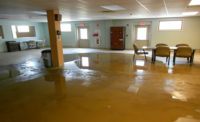Case Study Contest: Entries 5-8






Project 5: Massive Home Flood
Company: Golden Hammer Restoration, Inc.
The job: Three acres and a home was put three feet under water.
The solution: We built a sand bag and plastic dike 4 feet high around the house. We used a back hoe to dig 4 large pits in the yard, allowing the water to drain into them as we dug. We placed large pumps in the house and pumped the water out of the house. We then set up generators on trailers still in the water outside of the house, decasent dehumidifiers and fans in the home. We completed the job using 4 wheel drives and trailers to load out and in building material. The last week of the restoration the water went down far enough that we helped the owners bring in their new furniture and appliances in. The family moved back into the house with 90% of their yard still under water, with the sand bag dike built around their home!
Project 6: Removing 9 Tons of Waste
Company: Mastertech Environmental
The job: Two-bedroom New Jersey home required cleanup of over 20 years’ worth of bagged human waste.
The solution: Our first task was to dig a path to the area where the decedent passed so we could address the body decomposition. Large snow shovels and trash carts helped make this happen relatively fast. Once the medical waste from the decomposition was separated and removed, the crew of 8 got to work removing the piles so we would have somewhere to place air scrubbers. Once the entire house was under negative air pressure, the bulk removal continued with snow shovels and trash carts. Most of the bagged feces had long since dried up and was easily removed. The lower sections of the 8’ piles however, remained damp and many of the bags had ripped open.
Almost all of the hardwood flooring beneath the piles had to be removed down to the joists due to rot – not to mention odor and pathogenic bacteria. After all of the bulk waste was taken away and the affected building materials were removed, all surfaces were treated with a broad band disinfectant and scrubbed – 3 times. All remaining drywall walls were cleaned with a degreaser to remove of the decades of cigarette smoke and embedded nicotine. Ozone was used for four 12-hour periods to help with the odors that remained.
Challenges: We were tasked with removing 20 years’ worth of built up human feces and urine from a hoarding house which had no running water - for 20 years. Plus, the occupant (an elderly man) died in the house and decomposed for approximately 3 weeks. The man had chain smoked in the house, drank vodka and Gatorade, and since he had no running water for 20 years, used the empty bottles to urinate in. He also used small, plastic bags (from the liquor store) to defecate in - again, for 20 years. The piles were as high as the ceiling in many areas and there was at least 3 feet of waste on all floors except one - his bedroom. The man's family was mortified at the living conditions and tried hiring 2 other local companies to clean the house. They both refused.
Project 7: Acclimated Dry-Out
Company: GLS
The job: A residential water loss where the owner of the rental house was a commercial cleaning client of mine. This loss had over 3,700 gallons of water in the finished basement.
The solution: Once I could free up some power by peeling off LRG's and fans I placed an E-TES into my vortex and the hot dry air helped reduce several walls that still had a moisture content of 25%-46%. After 1 day of directed heat assistance, the painted room was dry as well as the few various pockets of moisture along one of the exterior walls. This loss was 2 hours away from both my office and home so I was rather thrilled that I was able to pull my final out and call my troops in to perform the post cleaning and sanitizing.
Challenges: The client was paying out of pocket, so measures were made to keep the costs as manageable as possible, yet follow IICRC S500 guidelines.
Project 8: Restoring Nancy O’Dell’s (of Entertainment Tonight) House
Company: Allied Restoration
The job: Water damage from somewhere near or in an upstairs bathroom that was putting her dining room ceiling at risk
The solution: Located the leak using thermal cameras and accessed the leak from the upstairs bathroom to save construction costs.
Challenges: The ceiling was made of original wood from when the house was built in the 1930s. It was priceless and to cut into it to find the leak would cause massive damage.
Looking for a reprint of this article?
From high-res PDFs to custom plaques, order your copy today!









